One of Thrivestry's Secret Ingredients That Makes People More Awesome, the "Strength Focus"

CrossFit is known for being "constantly varied", but that doesn't mean random. Can we improve results, make the classes easier (to learn movements and to coach), while improving safety and ensuring that people make gains for more than 10 years?
Yes.
And we can do that by using what we call the "Strength Focus".
Why have a “Focus” at all?
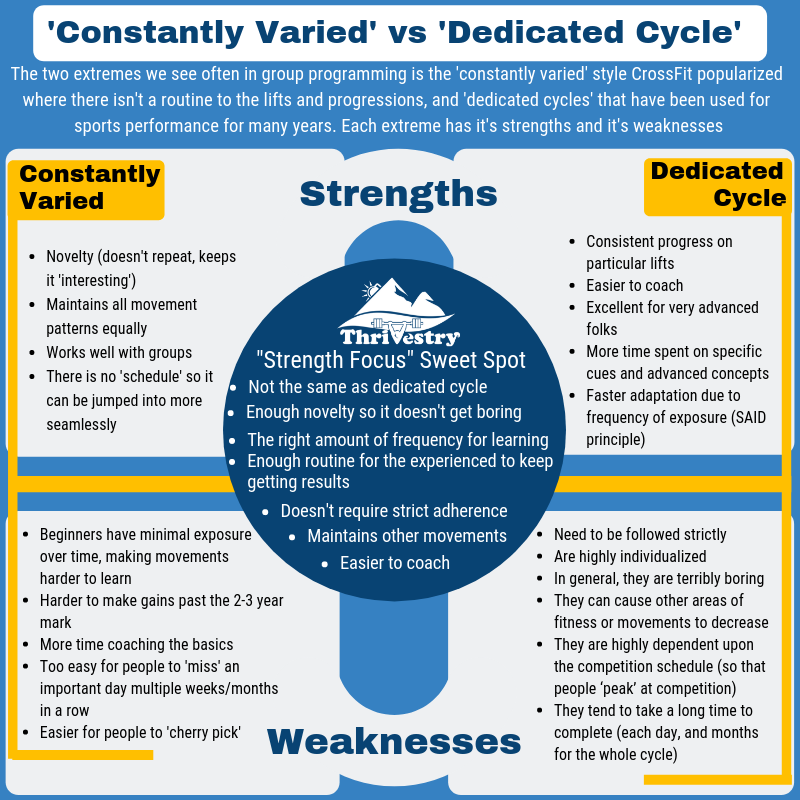
CrossFit can be credited with demonstrating the power of ‘constantly varied’ or ‘seemingly random’ training for making people fit. While this style of training is good for ‘metabolic conditioning’ and keeping things not boring, it isn’t the best for making strength gains in the short term, and overall gains in the long term. And yet, many programs still adhere to this style of programming, even with lifting.
What makes Thrivestry different is that it is built upon over a decade and a half of experience and testing with training regular folks in a group environment (as well as Games athletes) culminating with tens of thousands of workouts completed by thousands of people for years.
We have tested the purely ‘constantly varied’ style of programming as well as the more traditional ‘linear’ cycles that have been used by athletes for many years before CrossFit.
What we have found was that when we focus on metcons most of the time (and lifts only 1-2 times per week, aka a “metcon focus”), people tend to plateau within a few years. Their body composition doesn’t progress any faster than a more blended style, and eventually stops completely. Their scores on benchmark workouts stop improving. We’ve even saw an uptick in soreness and injuries.
On the other side of the coin, when we tested lifts plus a metcon every day (or nearly every day), people tended to not have enough time each day to really learn and get better at movements (if the metcons were longer than 10-15 minutes). They had increased injuries. They got bored. Body composition suffered.
What we determined was that a mix of skill plus metcon and strength plus short metcon (about 50% of each) was the best way for people to make gains. It allows more flexibility as people have more options on what days they can come (to customize their own experience). It allows continual strength gains, while also giving enough of the ‘potent medicine’ of metcon to get the benefits from the high intensity conditioning.
The next big evolution was the incorporation of a structured “Strength Focus.”
The benefits of the strength focus are multi-faceted (and why it is so amazing).
Beginners
For beginners, doing a lift once a month or every other month is daunting and frustrating. Trying to learn dozens of movements, each with dozens of technical points is hard enough. Only being able to practice these movements every month or so means that it may take years to start to feel comfortable with the movement (sometimes longer). It is also easy to underestimate your abilities and not get much of a stimulus because you have to lift so “light”, OR you may end up going too heavy and risk injury (or practicing bad form).
By practicing a movement 1-2 times per week for 6 weeks or so, you’ll be able to really learn the movement. You’ll remember the names. Your coaches will be able to give you better cues. And you’ll see significant gains over the 6 weeks before moving on to another lift.
Seasoned Folks
More seasoned folks (people who have a lifting background or who have been training for more than a few years) will find that without regular exposure, their lifts won’t improve and their metcons will not get much better. By hitting the lift 1-2 times per week, you are far more likely to squeeze another 10-20lbs on a lift that you have been struggling with for years. You will also get the benefit of better coaching. Because the coaches aren’t having to teach the lift from scratch every class (because the beginners are struggling to learn it since it is so ‘new'), they’ll be able to give you more direct and advanced coaching cues.
There is also the motivation of setting a new PR when PRs become fewer and farther between!
Coaches
By dedicating 1-2 days per week to a particular lift, your newer folks will have an easier time learning the basics. You will spend FAR less time explaining what a clean or is, or the differences between a back squat and a front squat.
You will be able to go into the nuances with your more experienced folks. You’ll also have more time to create a better class experience and build the relationships that keep people around for the long haul.
Everyone
The 6 weeks is not arbitrary. 6 weeks happens to be the point at which it becomes more and more difficult to make gains with one particular movement pattern without getting very creative (bands, chains, other weird implements, etc.) and more specificity (specializing in the movement at the detriment to other domains). 4-5 weeks isn’t quite long enough to get the maximum return on investment. 7-8 weeks tends to be a bit long (requiring that specialization piece).
6 weeks also happens to be when most people start to get mentally ‘tired’ of the movement. The first 2 weeks is full of learning (and a bit of a ‘deload’ from the previous focus). The middle two weeks is more of a ‘punch the clock’ where we show up and put in the work. The last two weeks are a grind, but we can see the light at the end of the tunnel.
Everyone benefits because we are all working together toward a similar goal. PRs breed more PRs in a community environment. We all win when our gym-mates are ringing the PR bell or posting about it online.
A further note about the 6 weeks (changing up the metcon volume)

Because we are starting the first 2 weeks with lighter lifts, we are able to do a bit more metcon. We increase the duration of the metcons and add a bit more volume.
The middle two weeks are a more balanced mix of metcons and strength volume.
For the last two weeks, we’ll be lifting a bit more heavy and more frequently. We reduce the metcon volume (and duration in many cases) so that you are more able to hit the prescribed percentages.
If you are someone who likes more metcon (and really aren’t a fan of the heavy lifting), and on week 4 or 5 you are needing your ‘metcon fix’, don’t worry! In a week or two, we’ll be back to more metcon and less lifting.
If you are someone who loves to lift, and you are feeling a bit ‘beat down’ from all of the metcons on weeks 2 or 3, don’t worry! In another week or so, we’ll be back to doing more lifting and less metcon.
A Note On “Cycles”
The ‘Strength Focus’ should not be confused with the ‘cycles’ that are used in more traditional Powerlifting and Olympic lifting training.
Trying to force ‘regular folks’ into a true cycle is a mistake. Cycles are best used for advanced lifters who are looking to specialize in their sport’s particular movements.
- They need to be followed strictly
- They are highly individualized
- They are terribly boring (compared to more ‘constantly varied’ programs)
- They can cause other areas of fitness to decrease
- They are highly dependent upon the competition schedule (so that people ‘peak’ at competition)
- They tend to take a long time to complete (each day, and months for the whole cycle)
The Strength Focus is designed to maximize the benefits of having SOME routine, without suffering the drawbacks of trying to force groups of people into a generic strength ‘cycle’. (See Graphic at the beginning of the article)
The Basics
We do a 6 week strength focus… well… every 6 weeks. We’ll do a test a week or two before, then test a week or two after. During that strength focus, we’ll do the lift (and super set) approximately 2 times per week over the 6 weeks (for a total of about 11 – 13 sessions not including the tests).
The sessions are planned so that if one or more are missed, it is easy to know where to jump in at and some progress will still be maintained (it isn’t a simple “linear” program).
We will be doing other lifts in-between the strength focus days so we can maintain our strength in the other movement patterns (and for variety/novelty).
The days of the week the lifts are on change each week so that no matter what your schedule, you can still expect to get an adequate dose of the lift to see gains by the end (as long as you are coming 3-5 times per week consistently). That said, we also publish a calendar of the lifting days so you that if you are keen on making the most of that focus, you know what days to show up to make the most progress.
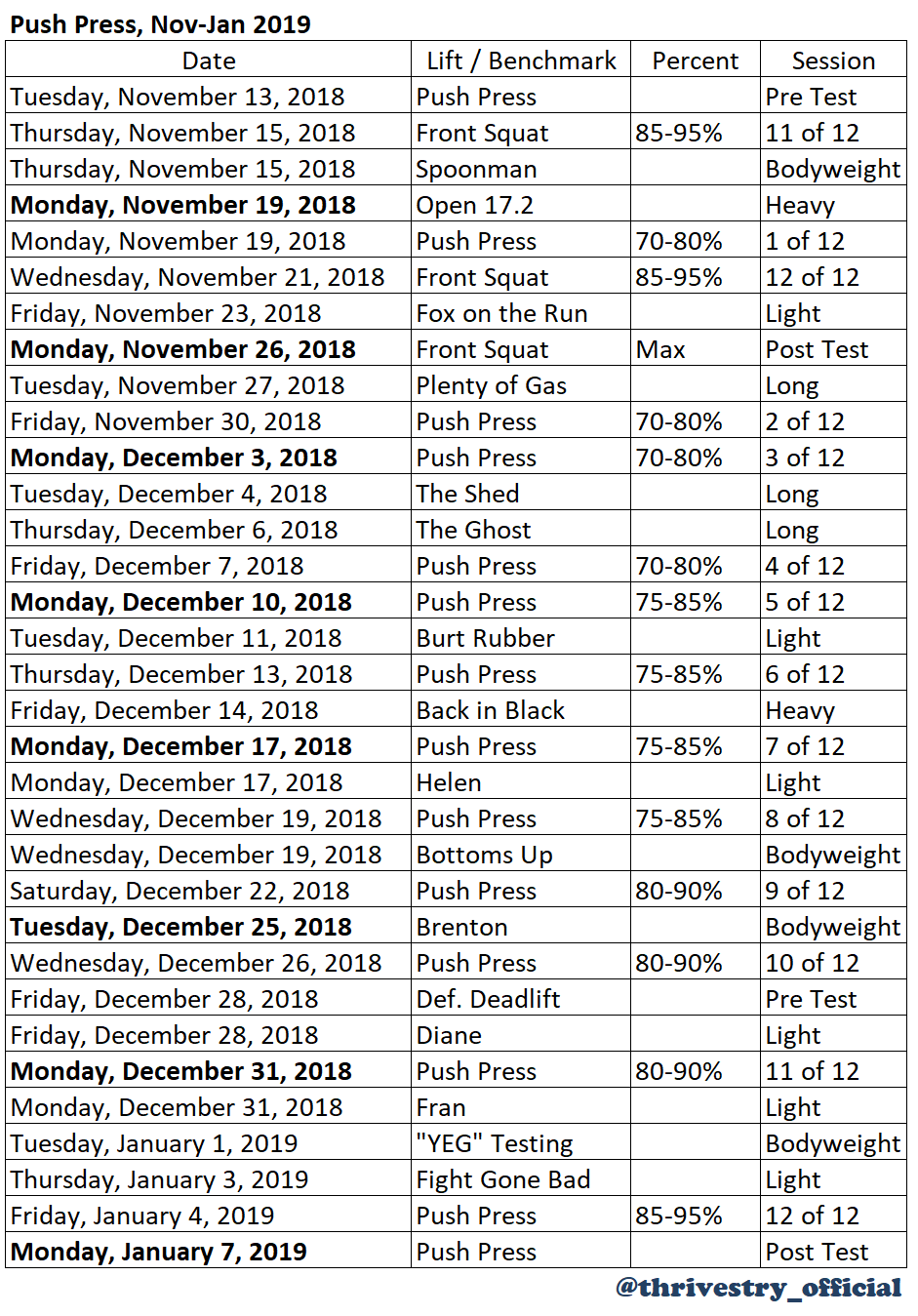
(Example of a Strength Focus Calendar, the calendar also includes 'benchmark' workouts so people can be sure to show up on their favorite benchmark days)
Because we are doing the lifts 1-2 times per week, it isn’t a good idea to do a ‘max effort’ style of session (X-X-X-X-X, where load is added each set). Doing this style so often, when combined with other lifts and metcons, will outpace your ability to recover and set you up for burn out or injury.
Percentages?
Using the recent test, we can prescribe a percent range. This isn’t a fixed percentage because percentage based lifting is very finicky and is really only good for dedicated programs, followed exactly, by experienced lifters (see the note on ‘cycles’ above). The range is there to give you some wiggle room and help you understand where you should be at over the 6 weeks. They key thing to remember here is that you should be starting at the percentages listed on weeks 1 and 2, then adding either weight or reps each session as the strength focus progresses.
There is no need to bust out a calculator every time. If the percentages are the same as the last time you did the lift, do the same weight (usually with more reps and/or sets). If the percentage is more, add roughly the amount prescribed (rounding to 5-10lb increments). Round down if the last session was ‘hard’ or if you aren’t feeling it today. Round up if the last session felt good or ‘easy’.
How much to go up and where to finish at the end?
As a rough guide: for upper body movements, you’ll probably be adding 5-10lbs each jump (usually there is 3-5 ‘jumps’ per focus). For lower body movements it will probably be 10-20lbs per jump.
For example, if you tested your squat at 160lbs and the first session is 70-80%, that means you’ll be starting at about 120lbs (for reps). If the next jump is 75-85%, you’ll add 10-20lbs so you’ll be squatting 130-140lbs according to how your last session felt, your form, and what your coach says.
Over the course of 6 weeks, this means you’ll usually end up lifting 40-60lbs more than when you started. For many beginners, it might even mean that you are lifting more than your original test but for multiple reps and sets!
More advanced folks should be shooting to get close to their old max (85-95%), but doing it for multiple reps per set. Then for the test out, the goal is to go over your old max for a single, or do your old max for multiple sets of 1.
Adjustments in the earlier weeks
Depending on the initial test in, you may need to make some extra jumps (or smaller jumps) the first week or two. If you and your coach agree that the first week it was too light, add some weight (even if the percentage is the same). If you and your coach agree that the weight is a bit heavy and you won’t be able to continue to make progress the whole 6 weeks, drop back a bit or stay at the same load the next time there is a prescribed weight (percentage) jump.
The goals of the first 2-3 weeks is to build some quality repetitions with the lifts and to focus on correcting form before the load gets ‘heavy’. These lifts should be ‘hard’ because you are trying to do them perfectly or work on very specific technique fixes (not because of the load).
Finishing of the 6 weeks off right
Toward the end of the 6 weeks, it is common to struggle to hit the prescribed sets and reps. Ideally, the last sets during weeks 5 and 6 should be very hard but still ‘doable’. If you cannot complete the last sets, break them up into smaller sets and finish the total number of reps prescribed (if it is 5x5 and you do 4 sets of 5, do 3 and 2 on your last set so you still did 25 reps).
If this is just because you were ‘off’ that day, try the prescribed loads for the next session. If you know you aren’t going to be able to finish them as written, drop the weight back a bit (or if the next session is a weight jump, make a smaller jump).
If you are rolling into weeks 5 and 6 and the weights are still feeling ‘light’, make some extra jumps so that you can finish the focus strong.
Some notes on how the cycles fit together
When looking at the bigger picture, it is important to point out that the strength focuses are designed to fit together and lend ‘momentum’ into one another.
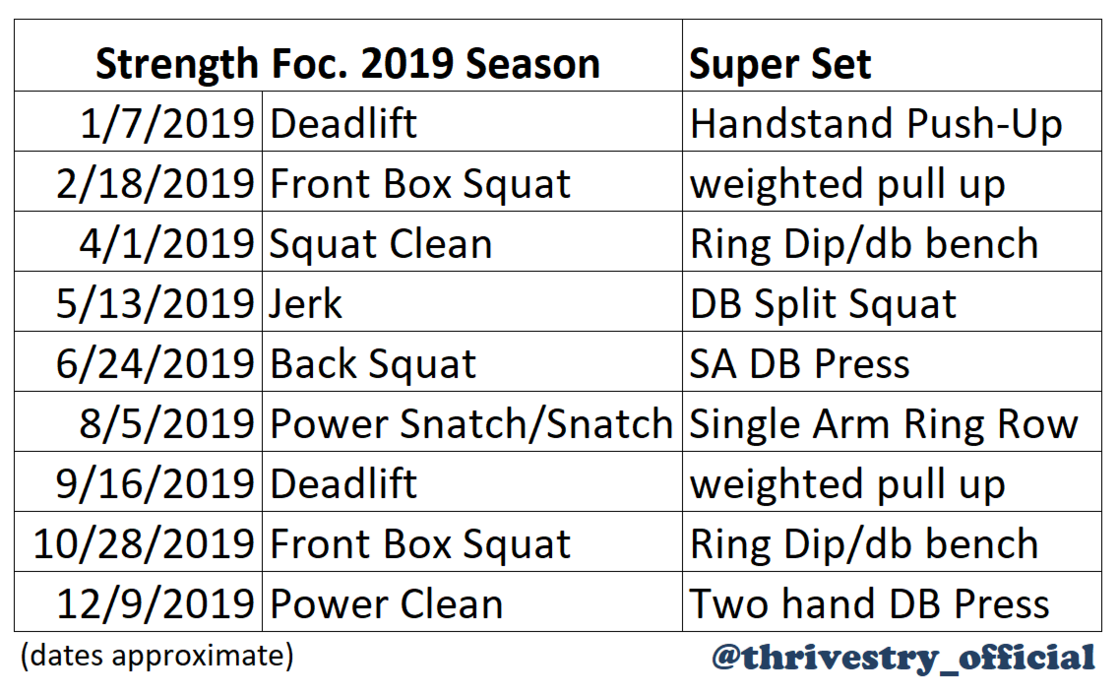
(2019 Lifts and Superset Schedule Example)
For example, it is common to do single leg deadlifts as the super set movement for 6 weeks before we do deadlifts as the primary movement. We’ll do split squats before a squat focus. Before a press heavy focus, we may do ring or dumbbell rows as a super set to help balance out the shoulders and set people up for success.
The lifts in particular are also scheduled around the annual ‘seasons’. Starting in late Fall early Winter, we focus a bit more on the barbell to set people up to do a barbell meet or CF competition. Toward the end of winter and into the Spring we do more running so people can enter a Spartan (or similar) race and because we do Murph on Memorial Day weekend. In the Summer and early fall we focus on the sport of CrossFIt so people can be ready for the CrossFit Open.
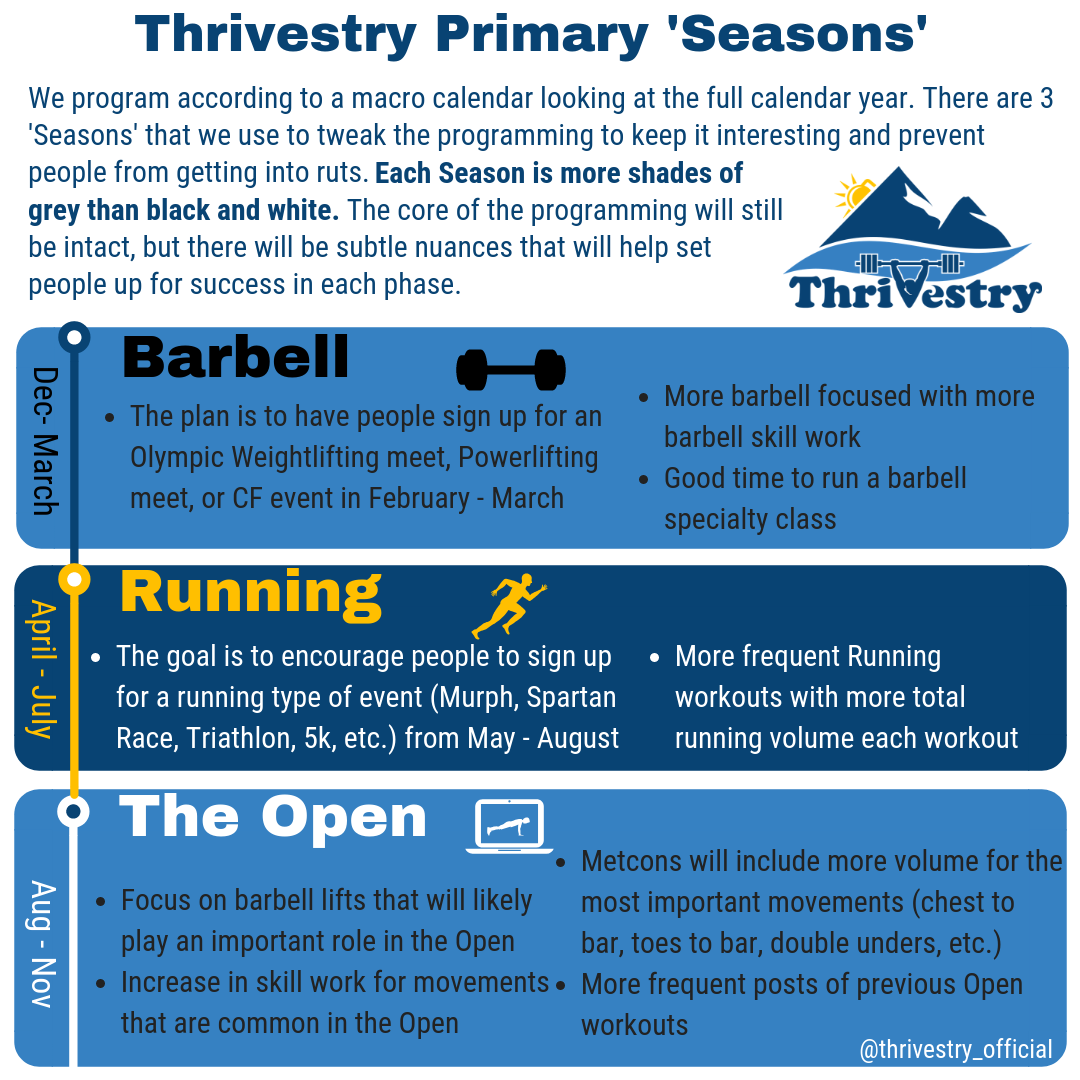
(Above graphic recently updated due to the changes in the 2019 season)
We Have Only Scratched the Surface
Believe it or not, we have only covered PART of the equation! I could continue on and on about the nuances of the Strength Focuses and more of how they make the Thrivestry program unique and powerful…
But I’d wager that most of you that have made it this far have taken in enough. Maybe I’ll record some videos of seminars in the future where I break everything down into greater detail. Until then, don’t hesitate to ask questions if I didn’t provide the answer here!
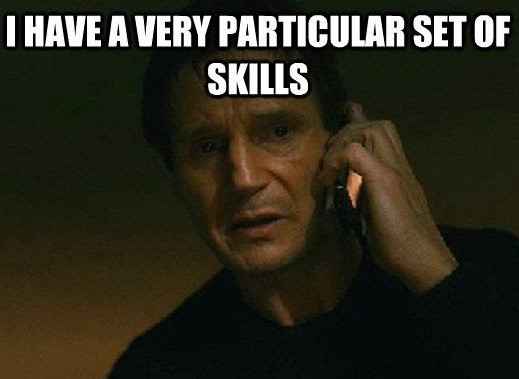
And if you take one thing away from this article, understand that there is a method to the madness, that it is built on a very particular set of skills, and that your coaches can guide you on the best path to your goals.
Thrive on.
-jj
Please share this if you found it useful or if you think it might help someone else.
Here are a few other things you may find interesting:
Movement Frequency in Thrivestry Compared to Other CrossFit Programs
It should be obvious by now that I love data and numbers (so you don’t have to), but I’d like to take some time today to break down some numbers ‘behind the curtain’ so you can understand some of the data behind what we are doing, as well as how it is different than many other programs out there.
What Programming Can and Can't Do for Class Experience Part 1
As more and more gyms start to realize that good programming takes time, we are starting to see many come around to the idea of hiring experts to provide the best results while saving the time and the headache of always worrying about the programming.
That said, I haven’t seen enough discussion on where the lines between good programming and good coaching cross, and what each can and can’t do.
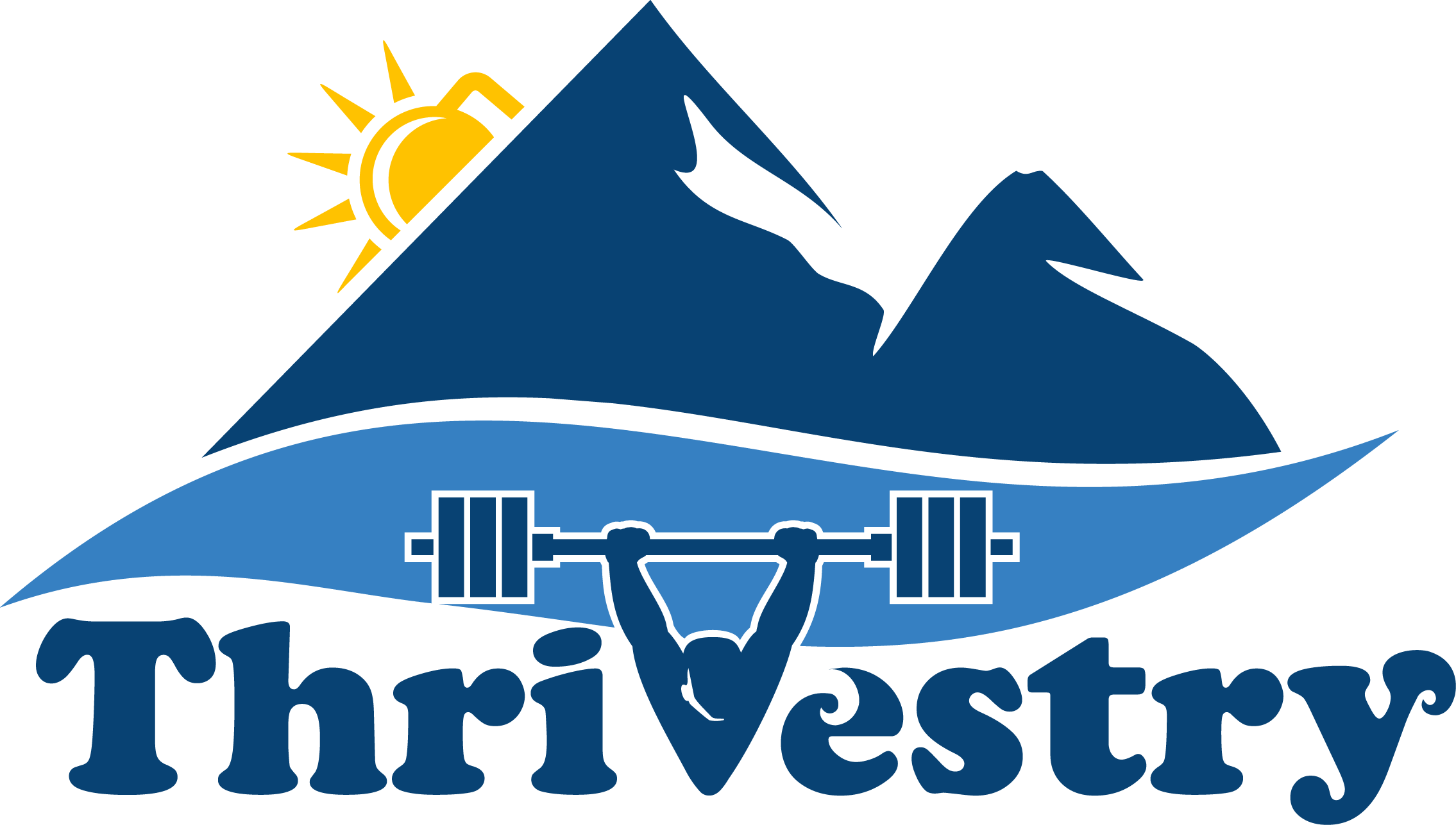
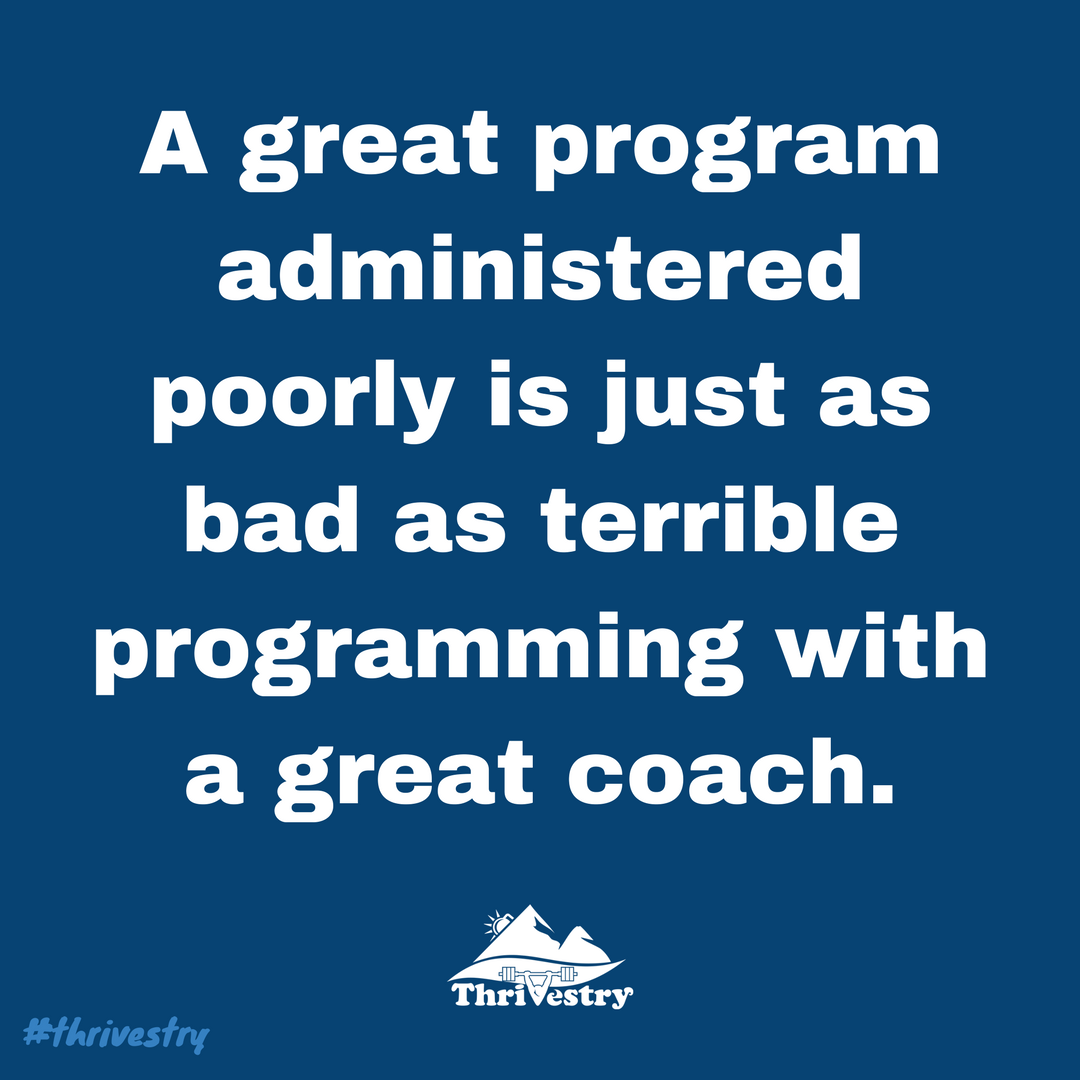
0 comments
Leave a comment